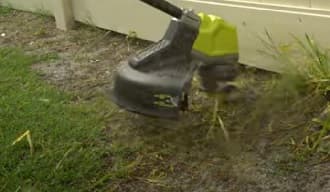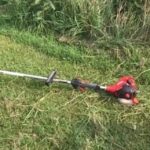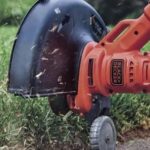As an Amazon Associate, this site earns commissions from qualifying purchases. For more information click here.
Is your weed eater line always coming up short? Or does it break often? Either one is a sign that you might be using the wrong string trimmer line size. The length, diameter and material of a line makes a huge difference for string trimmers, weed eaters and weed wacker. All these and more are explained in this article.
The larger the string line, the thicker the weeds and grass it can cut. The greater the line diameter, the less vulnerable it is to wear and tear. Large lines require more engine power though, so make sure your string trimmer has the capacity for it.
Weed Eater String Size Chart
String trimmers can use different lines, but the capacity depends on the make and model. Check your owner’s manual for your weed eater line size compatibility.
If you do not have the time to go through this entire post, here is a chart. These are the most common sizes and compatible with popular string trimmers including the Dewalt Flexvolt 60V Max Trimmer. Look into your owner’s manual if you are not sure of compatibility.
| Weed Eater String Diameter Size | Best Used For |
| 0.065 – 0.080 in. | Small trimming tasks, new weeds, soft grass, for small homes |
| 0.080 – 0.110 in. | For large weeds, trimming large gardens and yards, for standard sized homes |
| 0.110 in and larger | For large landscape projects, very thick weeds, golf courses, commercial use, large properties |
The larger the line, the more durable it is. If your string is constantly breaking, you need to get a thicker line. Most string trimmers can handle these line sizes, but look into the operating manual to be sure.
Also keep in mind that the larger the string, the more space it takes up on the spool. This should not be an issue if the string is durable it is not going to break often. But you have to consider that if you trim large areas regularly.

What Weed Eater String Size Do You Need?
The right string size is the one that matches your needs. Start with the manufacturer recommended line and type. If you own a Craftsman WS4200, the manual has information on what lines you can use with it. As you will see in the following, you do not always need the thickest string to get things done.
The weed eater line size depends on how thick the growth is. The thicker the growth, the larger the string. Of course you also have to make sure the weed eater can support thicker strings. While large lines can cut more, it also requires more engine power.
To give you a better idea of what weed eater string sizes are for, here are some general guidelines.
0.065 – 0.080 Inches
This weed eater line is for light work. It is suitable for trimming soft grass, lawn edges and some weeds.
If you use this string properly, it should last a while. It is not as durable as thicker lines, but for light trimming it will be enough. Do not use these strings on gravel, concrete and rocky surfaces. For small gardens and light trimming, these strings are fine. You can use practically any string trimmer with these.
0.080 – 0.110 in.
This trimmer line size range is useful for thicker grass and weeds. If 0.065 – 0.080 Inch lines break frequently, consider using these instead. The larger diameter means more cutting power and majority of weed eaters support these as well.
These weed eater lines are more durable than their thinner counterpart. These are made for grass and weeds, but using them on rocky or cement surfaces will not immediately damage them. As much as possible though these medium size wed eater lines should be used on grass and weeds.
0.110 in and Larger
For thick grass, heavy weeds and large scale yard work, a 0.110 or larger string diameter is ideal. Sizes greater than 0.110 can go through brambles, nettles and other materials that light cords cannot.
These are thick and heavy strings which can cut through weeds and grass with ease. They are the most durable types available and the best option if you trim lots of heavy grass.
These string trimmer lines are for residential and commercial use. For most home owners, the 0.110 size is the most that will be needed. For buildings with landscapes, golf courses etc. they will need strings with larger diameters.
Almost all string trimmers can accept lines up to 0.110 inches thick. Beyond that it varies. If you need a thicker line, check your manual if the trimmer supports it. The thicker the line gets, the more power is required and the more space it will take up in the spool.
Related. 7 Reasons Your Weed Eater Will Not Run at Full Throttle
Types of Weed Eater Strings Explained
Now that you know what line sizes are available, you can choose which line type to buy. The following are the most common and compatible with most string trimmers.
Round Weed Eater String
Round trimmer lines are the most widely used for good reasons. Due to its shape, the line is less likely to break or snap off if it strikes a hard surface.
Round trimmer lines are very common and used by all weed eaters. It is easy to manufacture, affordable and long lasting. You won’t have trouble finding a replacement for round strings. For most home owners, this is the only type of string needed.
Square Weed Eater String
Square trimmer lines are not as common as the round ones, but it works well on thick weeds. Landscapers and gardeners also use this to get rid of hard to remove weeds and grass.
The edges on a square weed eater line allows it to trim weeds and grass efficiently. Even those that are hard to take out are not a problem for these lines. For these reasons a lot of seasoned gardeners and professionals prefer this.
Square trimmer lines are built for long term use. Unlike other lines, it can withstand contact with concrete and rocky surfaces. If it feels more rigid than a round trimmer line, that is because it is built more solidly.
Serrated Weed Eater String
As the name makes clear, serrated weed eater lines have teeth which allows it to cut through grass, shrubs and weeds cleanly. It gives your yard a more polished, clean look and works well for homes and offices alike.
Serrated trimmer lines are stronger than round ones. They can handle large weeds, thick grass and other stuff that a typical line cannot. However, the extra cutting capacity does require more power. If you want to use this, make sure your string trimmer supports it and the engine can handle the additional demand.
Multi Sided Weed Eater String
Multi sided trimmer lines are often used in large gardens and lots of thick grass. The unique design makes these lines ideal for commercial and professional applications. If you have a large garden this can prove useful as well.
A multi sided trimmer line is more durable and made for cutting large amounts of grass and weeds. The cuts are sharper and cleaner and makes short work of thick plants, bushes and weeds.
Twisted Weed Eater String
A spiral or twisted trimmer line is used to trim thick weeds, grass and shrubs. Its unique shape improves performance and durability.
The twist also reduces the sound the weed eater makes, so it is a good option if there are noise restrictions in your area. So if you are worried about the noise, a twisted weed eater is the way to go. You can also use a spiral line if the round one is unable to cut the thick weeds in your home or commercial property.
Like square and multi sided trimmer lines, twisted strings are stronger than round lines. It can handle contact with hard surfaces, and the noise reduction is a definite plus.

I love the outdoors and all the tools for maintaining gardens, yards and lawns. The only thing I am more passionate about is sharing what I know about garden and outdoor equipment.


